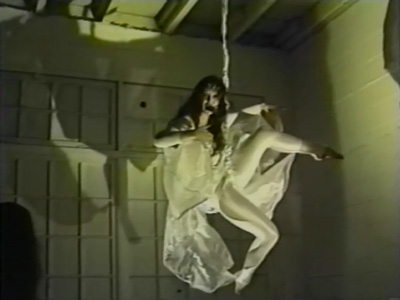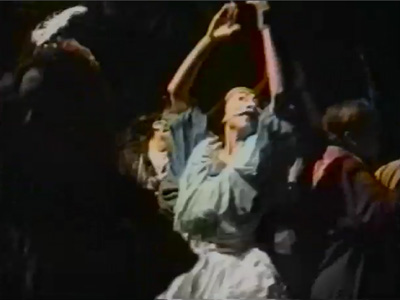- Home
- Projects
- Essays
- Paula Jardine: The Role of Celebration Arts
- Melanie Fernandez: Community and Art A Runaway History
- Oliver Kellhammer: Botanical Interventions
- Caffyn Kelly: Better Than Sex
- Glenn Alteen: ATSA Dystopian Realities
- Chris Bose: The Other Side of the River, Engaged Arts on the Rez
- Devora Neumark: How At Home Are We Really? Art, Diversity, and Dwelling in Canada's Multicultural Landscape
- Tania Willard: Access All Areas: Conversations on Engaged Arts
- Credits
1991: Masque of the Red Death
Video
All videos require the free QuickTime plugin (external link)

Sandra Lockwood aerial performance
3:29
Suspended from the ceiling Lockwood sings a plaintive song of loss, while performing acrobatic movements, with cutaway shots of the sculptural art installation around her.

Ballroom masked dancing
3:00
The audience is mixed together with masked performers, they are all dancing to a group of minstrels. The music becomes more and more frenetic, until a man in a suit (a performer?) begins to disrobe, running in a circle until he collapses, with cutaway shots of the the sculptural art installation around them.
Masque of the Red Death was a collaboration between grunt and Public Dreams of a multimedia production based on the Edgar Allan Poe short story of the same title. In this version, produced during the height of the AIDS crisis, seven artists were commissioned to develop installations addressing levels of denial within our culture. Public Dreams then commissioned individual artists to produce performances in each of the rooms, based on the artists’ themes; the audience participated in the event by becoming the guests that attended Prince Prospero's ball. Many participated through all nine performances.
Masque was an important milestone for grunt for a host of reasons. It was the largest project we had ever produced and it changed the way we did things. Because it included a full-scale renovation of a 5,000-square-foot warehouse space that fully complied with permitting, fire code and zoning laws, it really tested the limits of both organizations. It was an important lesson in dealing with city hall and the regulators, and we learned a lot through it. More importantly it served as an introduction to the First Nations community, working with Archer Pechawis, Aiyyana Maracle and Donald Morin. It started a relationship between grunt and the First Nations community that exists to this day. Also, the mix of grunt and Public Dreams started a relationship that has reaped bounties for this type of work. Masque is where Marina Szijarto and Paula Jardine met, later collaborating on their Day of the Dead festival in Mountainview Cemetery.
The project found its audience mostly through the TV coverage. A couple of reviewers were less then impressed, but the audience that showed really was up to the spectacle. It was a lesson in marketing and finding a community for the work. It was an important step in our education around community-based practice.
PUBLICATION
THE GEORGIA STRAIGHT - NOVEMBER 1-8 91
Masque of the Plague Years
Download as pdf, 127K
Requires the free Adobe Reader
The grunt gallery and the Public Dreams Society team up to revive Poe's timely fable of decadence and denial in the face of death
Resilient realist Glenn Alteen oversees the production of The Masque of the Red Death, an undertaking more cursed than Macbeth.
BY NAOMI PAULS
“They say Macbeth is a cursed play,” says Glenn Alteen, lowering his voice, “but I think I’ve come up with an even more cursed one.” He unclasps the chain around his neck to display a small gold skull, complete with articulated jaw. He found it lying on the ground the same day he finally located—after much searching—a warehouse in which to produce his multi-disciplinary adaptation of Edgar Allan Poe's short story, "The Masque of the Red Death". An ongoing exhibition featuring regular participatory performances, The Masque of the Red Death is open daily from 11 a.m. to 6 p.m. at 1460 Burrard Street. The exhibition runs for a month, while performances take place Thursday to Saturday from October 31 to November 16.
Spooky, frightening, even macabre...The Masque of the Red Death is all those things. Yet the cackles of laughter that punctuate Alteen's discussion of his project indicate that, despite major set-backs and unnerving coincidences (a close friend who was to have been involved in the project is now dying of AIDS), he has not lost his sense of humour during the two years it has taken to bring his dream to fruition. Alteen confesses, between gulps of coffee and pulls on consecutive cigarettes, that the process of administering 40 staff, plus volunteers, has been an incredible amount of work and that the major scope of the project has been a challenge for all involved.
It was the timeless quality of Poe's story, as well as its timely message about decadence and denial in the face of death, that made Alteen want to bring it to life. "The story isn't much," he says. "It's the way it's written, more than anything. It's essentially just this morality tale about this prince who locks himself up in a castle and tries to avoid the plague, and has this big party, and has it in these seven rooms." But it's the seven rooms—each a different colour—that were, as Alteen puts it, "the kicker", providing a visual hook on which to hang his rendition of the tale.
Alteen, curator of the grunt gallery, chose seven artists to interpret each of the seven rooms, which have been constructed in a 4,500-square-foot warehouse under the Burrard Street Bridge. "Poe describes them as ballrooms," says Alteen, "so I really felt strongly that you had to feel a sense of spaciousness in them." The rooms range in size from 450 to 900 square feet, and the artists had free rein to develop their own themes. Marina Szijarto, in the Blue Room, will incorporate imagery based on a Guatemalan graveyard and the Mexican Day of the Dead, while Steven Graham, in the Purple Room, will evoke the glitter clubs of the mid-'70s, before the spectre of AIDS. The fearful Black Room, by David Asmodeus, draped in black velvet and housing the all-important clock, will most closely resemble Poe's vivid yet appropriately vague descriptions of the seven chambers.
From the beginning, Alteen conceived The Masque of the Red Death as an interdisciplinary, audience-participation production. To assist with realizing those aspects of the work, he enlisted the co-operation of the Public Dreams Society, known for its participatory public-art spectacles. Paula Jardine, artistic director of Public Dreams, co-wrote the script with Alteen—working from the artists' statements—and will direct the performance. But Alteen isn't saying much about that, other than it is not like theatre as anybody would know it.
Not only the players—a mix of actors from alternative theatre groups and independent performance artists—will be masked and in costume, but so will the audience, attending as the revellers at the ball. Alteen admits, with his trademark giggle, "The big 'if in this is what the audience is gonna do once you put them all in a mask. The audience has an opportunity to act like a character, and how much they, as a whole, take that opportunity will really be fairly interesting.
“My feeling is that if we can get people to read the story, we can get people to participate. If you read the story, I don't think you can help but go down and see what's goin' on."
While Poe's 1842 story may have been based on a real Parisian ball held a decade earlier during a cholera outbreak, his dark fable about Prince Prospero's denial of the Red Death resonates just as strongly today. As Alteen says, "It's not just AIDS. I mean, the cancer, the environmental stuff, all that stuff is about our denial to believe that we are coming to an end, that we are consuming faster than it can grow back.
“There are certain messages on the wall that we choose not to read, like Prince Prospero. I mean, he really is us."
If it all sounds a bit bleak, Alteen has a caveat. "We're not planning to depress everyone for months afterwards, or anything like that," he says. "I think people will be adequately amused by the whole thing and will maybe look at things a little differently than they did before...maybe. Maybe not."
And there's that cavalier laugh again—not unlike the hoot of a resilient realist flying in the face of adversity or death.
Due to the demanding scope of The Masque of the Red Death, the grunt gallery will be closed for November's First Thursday art night. However, the November 7 Masque performance should serve as an adequate stand-in.
Artists:
Artistic Director and Curator: Glenn Alteen
Artistic Director: Paula Jardine
Musical Director: Mark Douglas
Choreographer: Margaret Dragu
Artists: David Asmodeus, Steven Graham, Ron Huebner, Stan Lake, Danielle Peacock, Bill Rennie, Liz Scully, Marina Szijarto and Hillary Wood
Performers: Lesley Ewan, Sandra Lockwood, Donald Morin, Michael Vonn, Andrew Wilson and Richard Yee.
Technical Director: Archer Pechawis
Construction manager: Aiyyana Maracle
Administrative Assistant: Merle Addison
Carpenters: Kempton Dexter, Lajos Jakab, Aiyyana Maracle
Puppet Maker: Johanne Gallipeau
Desktop Publisher: Anne Jew
Costume Designer and Stage Manager: Margaret Knight
Managing Director: Glenn Lewis
Publicist: Ann McDonell
Poster Art: Carel Moiseiwitsch
Marketing Co-ordinator: Gary Ouimet
Project Manager: Elspeth Sage
The project was supported by the work of over 120 volunteers.













